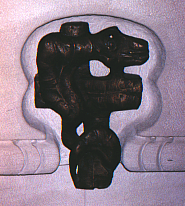SACREDNESS AND CREATIVITY
By:Ayesha Foot

Clear intelligent spaciousness
Matrix and turning point of the Cosmos
Focused illuminating emptiness
Holy, Holy, Holy is
(DW, p.245)
The last couple of weeks have been a whirling kaleidoscope of experiences which I am trying to integrate, but the overwhelming impression is of the search for a sacred space in which creativity can be found. Even our blue tits have got the idea : in the midst of the February snow I saw a little face peeping out of the nestbox, and since the thaw they have been busily building.
A women's retreat in Germany was guided by Kamae A Miller who has an extraordinary gift for creating a sacred space in which everyone feels safe enough to share their creativity, in word, picture, song and dance and in which ritual can arise spontaneously.
Afterwards, four of us made a pilgrimage to sites associated with Hildegard of Bingen, a woman who has been a great inspiration to me. Our first stop (for purely geographical reasons) was Otterberg, where there was a community who wrote to Hildegard for advice when they were close to despair. In her usual forthright way, she told them to get on with the job. Clearly they did, for the community flourished. The Church of the Ascension in Otterberg is a spacious building of warm sandstone, lofty and largely undecorated. We overheard a guide telling another group that its simplicity is symbolic of the pure heart, which seems apt in a church dedicated to the ascension of Mary, of which there is huge mural. On the opposite wall is a beautiful window to St. Cecilia, the patron saint of music, a reminder of the power of music to open the heart. The presence of the feminine face of God was tangible and warm.

There was even a serpent on one side of the altar!


On each of the doors to this lovely church is a
remarkable bronze handle depicting an animal, as though to find the transcendent
we must enter through the natural world.

This feeling was reinforced by our visit toDisbodenberg, where Hildegard lived for forty years, from the age of 8 until she set of with her nuns to found a new community at Bingen. The monastery was destroyed during the Forty Years' War, and little of it remains. It is set on an ancient Celtic site on a hill, a natural sacred place with very much the feel of a sacred grove, now that trees grow again amongst the ruins. On a bitterly cold January day we were the only visitors, the only sound the sighing of the wind. I could almost catch the echo of one of Hildegard's chants, O quam mirabilis est.
Then crossing the Rhine at Bingen, we arrived at the beautiful monastery as the sun set. Small wonder they have a waiting list of young women wanting to join the thriving community; the atmosphere is warm, joyous and purposeful, as I imagine its founder to be. We attended Vespers, which was pure aural ecstasy, the sweet singing of the unseen nuns transporting us.
Leaving my friends, I went on to visit a lady who was one
of my first Sufi teachers, Rabia Joyce Purcell. Her conversation is like a
firework display - sparks flying in all directions, reminding me of Hildegard's
words (op.cit.) -
The soul that is full of wisdom
is saturated with the spray of
a bubbling fountain - God himself.
She spoke of how she would like to write a book drawing together religion and philosophy, of the human search for reality, for a purpose in life. One of her thought provoking remarks was: Our creativity is our resurrection ... we must live our vision.
On the way back to England I was reading Zarathushtra : the transcendental vision by P.D. Mehta, Element Books 1985, now sadly out of print, when I came across:
The Perfected Holy One becomes, in mind and innermost consciousness, his realized Vision. Note carefully: he not merely sees or understands with his brain etc., but actually becomes the Vision, the Truth etc. The chrysalis becomes the butterfly, the bud becomes the flower. This implies the non-existence - the death - of the chrysalis or bud, the death which is not destruction or annihilation but a transformation or transmutation into the New - a progressive emergence into the New.
In order to get in touch with our vision we have to enter the sacred space. Ultimately, this is in our hearts, and in Desert Wisdom (HarperCollins 1995) Neil Douglas-Klotz gives practices which enable one to clear this space within, as we do when we dance the second line of the Aramaic Prayer of Jesus, Netqadash shmakh - one translation of which is:
Help us let go, clear the space inside
of busy forgetfulness: so the
Name comes to live.Prayers of the Cosmos, Neil Douglas-Klotz, Harper Row,1990
PLANTING PEACE - UNIVERSAL DANCES OF PEACE- For details of a residential weekend
Copyright © 1995 The International Communique Ltd
